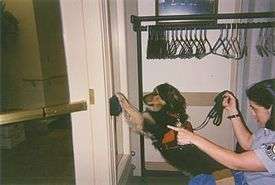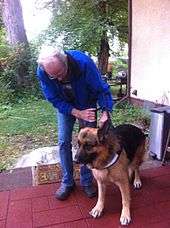Assistance dog

In general, an assistance dog is trained to aid or assist an individual with a disability. Many are trained by an assistance dog organization, or by their handler, often with the help of a professional trainer.
Classification

Assistance dogs fall into two broad categories: service dogs and facility dogs.[1] Service dogs are defined by the Americans with Disabilities Act as dogs that are individually trained to do work or perform tasks for people with disabilities. State and local governments, businesses, and nonprofit organizations that serve the public generally must allow service animals to accompany people with disabilities in all areas of the facility where the public is normally allowed to go.[2] Facility dogs are used by working professionals to aid multiple people.[3]
Common examples of service dogs include:
- Guide dogs assist the blind and the visually impaired.
- Hearing dogs, or signal dogs, help the deaf and hard of hearing.
- Mobility assistance dogs
- Medical alert dogs
- Psychiatric service dogs
Common examples of facility dogs include:[3]
- Courthouse facility dogs are typically handled by professionals working in the legal system. They are often used to assist crime victims, witnesses, and others during the investigation and prosecution of crimes as well as other legal proceedings.
- Facility dogs in educational settings are usually handled by special education teachers to facilitate interaction with the students.
- Facility dogs in healthcare environments are typically handled by physical therapists, psychologists, and other healthcare professionals to facilitate recovery and symptom management for patients.
In the United States, the term service dog may be used synonymously with assistance dog.
Similarities and differences between facility dogs and therapy dogs
Because both may aid people in similar settings such as healthcare environments, facility dogs are often mistakenly called therapy dogs; however, there are several important distinctions between them. Facility dogs are trained by accredited assistance dog organizations and therapy dogs are trained by their owners. Facility dogs may be handled by a wide variety of working professionals, while therapy dogs must be handled by their owners.
Facility dogs are trained by canine professionals for a period of 18 to 24 months, and must pass very rigorous tests before graduating from an assistance dog organization.[4] In contrast, registration for therapy dogs by a therapy dog organization does not require enrollment in obedience classes or therapy dog classes, meaning that therapy dogs often undergo a much less rigorous training process. Furthermore, the tests that therapy dogs must pass are less complicated and challenging than those taken by facility dogs.[5]
A person with either a therapy dog or a facility dog must have permission from the facilities they visit before they can enter with their animal. They do not have the right to demand access to places where pets are not generally permitted, or to have fees associated with their pets waived.[6]
See also
References
- ↑ Canine Companions for Independence
- ↑ Service Dogs - ADA
- 1 2 Facility Dogs - CCI
- ↑ Training Standards - Assistance Dogs International
- ↑ Therapy Dog Testing Requirements - Therapy Dogs International
- ↑ Rights - Service Dog Central
External links
- Service Dogs and More — large-print site about assistance dogs
- Assistance Dogs International
- Delta Society's National Service Animal Resource Center
- Service Dogs at DMOZ
- International Association of Assistance Dog Partners
- Service Dog Central — info and forum on assistance dogs
- Please Don't Pat Me Australia — information about Australian assistance dogs including laws and training standards